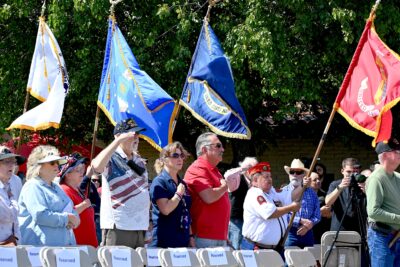After enduring tragedy in childhood, Gordon Rogers went on to perform one of the most hair-raising duties during World War II as a teenager, participating in America’s massive offensive to pulverize Hitler’s Nazi Germany.
Gordon was born May 12, 1925, in Burbank. Sadly, when he was but 7 years old, his mother died of colon cancer, and six months later, his father died of surgery complications at a nearby hospital. Because his father was a Mason, Gordon was raised in The Masonic Home for Children in Covina.
He graduated from Covina High School in 1942 and immediately joined the U.S. Army Air Corp at age 17. During basic training at Amarillo, Texas, Gordon qualified for the Aviation Cadet Program. After basic training, Gordon transferred to Missouri State Teachers College in Springfield for one year, which included flight training.
After training in Springfield, he went to a six-month gunnery training course at “Flexible Gunnery School” in Harlingen, Texas. Gordon learned to fire twin .50-caliber M2 Browning machine guns and to operate a B-24 tail turret.
His training included firing twin 50s in simulators, firing at enemy planes on film, and riding around a local football field in a turret mounted on a flatbed truck firing at targets.
By 1943, having completed gunnery training, he was off to Midland, Texas, for Bombardier School. Gordon said, “I couldn’t hit a bull in the ass with a bass fiddle, and I washed out of Bombardier School.”
So it was back to gunnery school where he ultimately became a B-24 Liberator bomber tail gunner. Soon, these young men were off to Kansas City where flight crews were assembled and assigned to Casper, Wyoming for six months of simulated battle missions flying heavy bomber B-24 Liberators all over America. Their training was extremely technical given that time frame and many of these young heroes were still teenagers. They weren’t even old enough to vote.
Gordon’s next assignment, with his 10-man crew, was flying a B-24 Liberator to Bungay, England, from Kansas City. They flew to Newfoundland, Iceland, Wales, and then to Bungay where they joined the Eighth Air Force 2nd Air Division, 446th Bombardier Group, known as “The Bungay Buckaroos.”

The B-24’s spacious, slab-sided fuselage, nicknamed “Flying Boxcar,” was built around two bomb bays that held 16,000 pounds of ordnance. As a tail gunner, Gordon was joined by a nose gunner, two waist gunners, a top gunner and a ball gunner (bottom turret). These young men were fully trained and primed to bomb Hitler’s military facilities into the dark ages while warding off unrelenting attacks by Germany’s Luftwaffe.
B-24 Liberators flew at altitudes up to 20,000 feet where it was exceptionally frigid for these young gunners, and often they suffered frost bite in their small rotating turrets. These brave warriors remained tough and focused on their job at hand.
By late 1944, Gordon’s Flying Boxcar was conducting bombing missions over Salzburg, Austria; Berlin; and Roth, Germany while evading anti-aircraft fire and fighting off notorious Nazi Messerschmitt fighter planes.
On one mission, a huge chunk of anti-aircraft flak blasted into Gordon’s turret narrowly missing him, but he was so busy blasting away at Messerschmitts he barely noticed. As Nazi Germany withered under the bombardier’s constant carpet bombings, it was clear victory was at hand.

While flying over Berlin, Gordon’s B-24 failed to drop its ordinance and they had to manually release their bombs even though their targets had passed. On the way back home, due to the heavy weight, they had fallen behind their group and were vulnerable to attack.
Soon, a Messerschmitt Jet Fighter came up within range of Gordon’s tail gunnery position and Gordon fired several bursts at him, but there was no return fire so Gordon let him go by. Both men must have realized the war was plainly over.
Once the war ended, B-24 Liberators flew air drop missions up and down the Rhine River dropping food, clothing and medical supplies to German citizens; America’s vast offensive on Nazi Germany morphed into a noble humanitarian mission. German citizens gleefully waved as B-24 Liberators zoomed past only 100 feet in the air.
After the war, Gordon traveled to Hattiesburg, Mississippi where he was discharged. He flew back to Burbank and soon attended Cal Aero Technical School in pursuit of an aircraft engine license.
Gordon had a career at Pacific Airmotive Corporation in Burbank; he also joined the Cal National Air Guard. In 1947 Gordon married Joyce Whickboldt in Glendale, and they had one son. They were married 17 years when Joyce died of colon cancer – the same cancer that took his mother. In 1965, Gordon moved to Santa Clarita.

Three years later, Gordon married Mary Rose Riedmaier. With a gleam in his eye he said, “I met her in the prone position on a shooting range in Ohio.” They had been married 38 years when she passed away. At age 91, Gordon, a Valencia resident for over 40 years, stays active with his business, “Custom Plastic & Embroidery,” his “militaria” hobby and volunteering at Henry Mayo Hospital.
Gordon Rogers is very proud of his military service. I consider him a true American patriot.
Bill Reynolds is one of the “Boys of ’67,” Charlie Company, 4th/47th, 9th Infantry Division and is the director of Veterans Affairs for The Signal.













